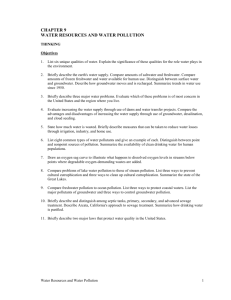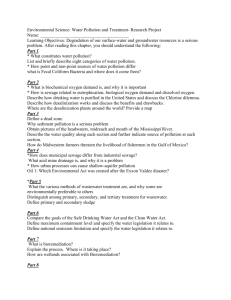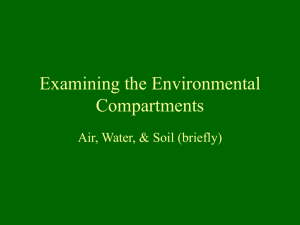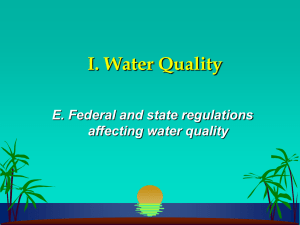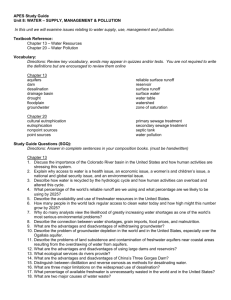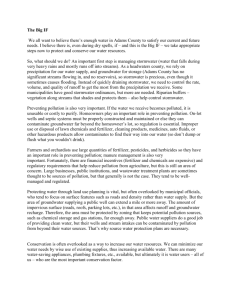Chapter 11 Section 3 Notes
advertisement
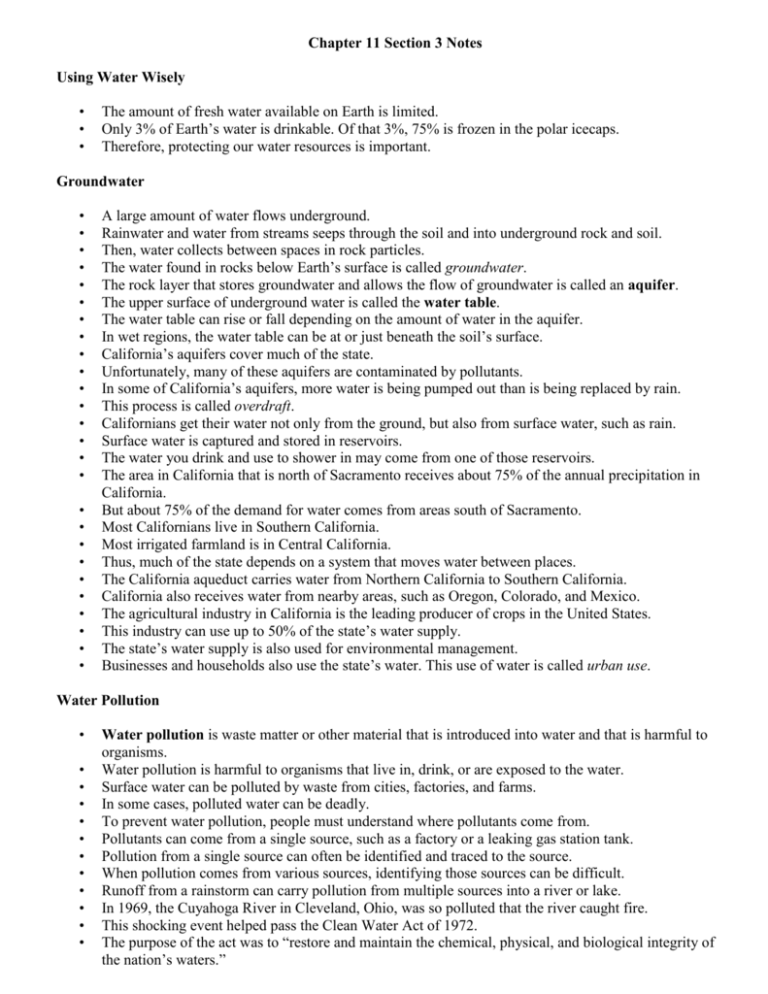
Chapter 11 Section 3 Notes Using Water Wisely • • • The amount of fresh water available on Earth is limited. Only 3% of Earth’s water is drinkable. Of that 3%, 75% is frozen in the polar icecaps. Therefore, protecting our water resources is important. Groundwater • • • • • • • • • • • • • • • • • • • • • • • • • • A large amount of water flows underground. Rainwater and water from streams seeps through the soil and into underground rock and soil. Then, water collects between spaces in rock particles. The water found in rocks below Earth’s surface is called groundwater. The rock layer that stores groundwater and allows the flow of groundwater is called an aquifer. The upper surface of underground water is called the water table. The water table can rise or fall depending on the amount of water in the aquifer. In wet regions, the water table can be at or just beneath the soil’s surface. California’s aquifers cover much of the state. Unfortunately, many of these aquifers are contaminated by pollutants. In some of California’s aquifers, more water is being pumped out than is being replaced by rain. This process is called overdraft. Californians get their water not only from the ground, but also from surface water, such as rain. Surface water is captured and stored in reservoirs. The water you drink and use to shower in may come from one of those reservoirs. The area in California that is north of Sacramento receives about 75% of the annual precipitation in California. But about 75% of the demand for water comes from areas south of Sacramento. Most Californians live in Southern California. Most irrigated farmland is in Central California. Thus, much of the state depends on a system that moves water between places. The California aqueduct carries water from Northern California to Southern California. California also receives water from nearby areas, such as Oregon, Colorado, and Mexico. The agricultural industry in California is the leading producer of crops in the United States. This industry can use up to 50% of the state’s water supply. The state’s water supply is also used for environmental management. Businesses and households also use the state’s water. This use of water is called urban use. Water Pollution • • • • • • • • • • • • Water pollution is waste matter or other material that is introduced into water and that is harmful to organisms. Water pollution is harmful to organisms that live in, drink, or are exposed to the water. Surface water can be polluted by waste from cities, factories, and farms. In some cases, polluted water can be deadly. To prevent water pollution, people must understand where pollutants come from. Pollutants can come from a single source, such as a factory or a leaking gas station tank. Pollution from a single source can often be identified and traced to the source. When pollution comes from various sources, identifying those sources can be difficult. Runoff from a rainstorm can carry pollution from multiple sources into a river or lake. In 1969, the Cuyahoga River in Cleveland, Ohio, was so polluted that the river caught fire. This shocking event helped pass the Clean Water Act of 1972. The purpose of the act was to “restore and maintain the chemical, physical, and biological integrity of the nation’s waters.” • • • • • • • • • • • The goal of the act was to make all surface water clean enough for fishing and swimming by 1983. This goal was not achieved. However, much progress has been made since the act was passed. The number of lakes and rivers that are fit for swimming or fishing has increased. Many states, including California, have passed stricter water-quality guidelines of their own. The Clean Water Act of 1972 opened the door for other water-quality laws. The Marine Protection, Research, and Sanctuaries Act of 1972 has strengthened the laws against ocean dumping. The Oil Pollution Act of 1990 requires all tankers traveling in U.S. waters to have double hulls by 2015 to protect against oil spills. The Safe Drinking Water Act of 1975 introduced programs to protect groundwater and surface water from pollution. Legislation has improved water quality. However, the cooperation of individuals, businesses, and the government will be necessary to maintain a clean water supply in the future. Water Conservation • • • • • • • • • • • • • • • • • • • • • Fresh water is a limited natural resource. To make sure we have enough to meet our needs in the future, we have to conserve it. Conservation is the preservation and wise use of natural resources. Farmers have learned that most water loss in agriculture comes from evaporation and runoff. The amount of water loss can be reduced by using drip irrigation. Drip irrigation systems deliver small amounts of water directly to plant roots. The plants take up the water before it can evaporate or run off. Many industries conserve water by recycling cooling water and wastewater. Instead of discharging water into a nearby river, businesses often recycle water and use it again. Conserving water at home is important. Low-flow toilets and shower heads can be installed to lower the amount of water used in the bathroom. To reduce the amount of water lost to evaporation, lawns can be watered at night. Water can also be conserved by landscaping with a technique called xeriscaping. Xeriscaping involves designing a landscape with native plants. Native plants don’t need to be watered because they receive enough water from the natural environment. When you join the millions of people who are trying to save water, you can make a big difference. Your behavior alone can help conserve water. For example, you can avoid running the water while brushing your teeth or washing dishes. You can take shorter showers. You can wash the car by using only a bucket and a hose that has a shutoff nozzle. You can run the dishwasher or washing machine only when they are full.


